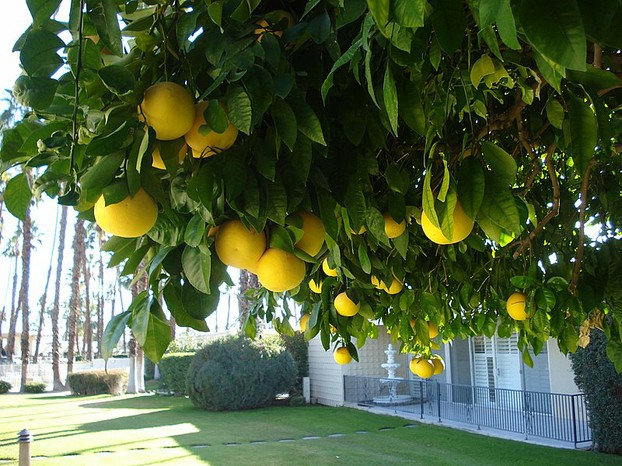UGLI fruit and coffee: Rachel Zack, CC BY 2.0, via Flickr @ https://www.flickr.com/photos/rachelmargaret/2886652974/
Publix Supermarket, Cocoa Beach, "Space Coast", east central Florida: Rusty Clark, CC BY 2.0, via Flickr @ https://www.flickr.com/photos/rusty_clark/7024265509/
closeup of leaves and fruits of mandarin orange tree (Citrus reticulata), Berkeley Botanical Garden: Quinn Dombrowski (quinn.anya), CC BY SA 2.0, via Flickr @ https://www.flickr.com/photos/quinnanya/8378434659/
Real Jardín Botánico, Madrid, Spain: A. Barra, CC BY-SA 3.0, via Wikimedia Commons @ https://en.wikipedia.org/wiki/File:Citrus_aurantium.jpg
closeup of leaves and fruits of grapefruit tree (Citrus paradisi), Palm Springs, southern California: Joe Wolf (JoeInSouthernCA), CC BY-ND 2.0, via Flickr @ https://www.flickr.com/photos/joebehr/2152848130/
Bob Marley's birthplace: adjacent to his mausoleum, on grounds of museum dedicated to his life and music: david_e_waldron, CC BY-SA 2.0, via Flickr @ https://www.flickr.com/photos/dwaldron/450610377/
University of California-Riverside's original Citrus Experiment Station, built in Mission Style in 1917: Amerique, CC BY-SA 3.0, via Wikimedia Commons @ https://en.wikipedia.org/wiki/File:Citrus_Experiment_Station.JPG
caliche forest, San Miguel Island, Northern Channel Islands, southern California: Toddclark, CC BY-SA 2.5, via Wikimedia Commons @ https://en.wikipedia.org/wiki/File:San-miguel-island-caliche.jpg
UGLI® fruit with white plate: Rabensteiner, Public Domain, via Wikimedia Commons @ https://commons.wikimedia.org/wiki/File:Ugli_Fruit.jpg
NOTE: Was 5th from last photo but moved two slots up (2/14/2022) to replace Herb Neufeld image
Das Innere einer Ugli = the interior of an Ugli: ni22co, CC BY 2.0, via Flickr @ https://www.flickr.com/photos/nicowa/6946623061/
UGLI® fruit open: Rabensteiner, Public Domain, via Wikimedia Commons @ https://commons.wikimedia.org/wiki/File:Ugli_open.jpg
"Ugli on the outside, lovely on the inside": REL Waldman (Ariel Waldman), CC BY-SA 2.0, via Flickr @ https://www.flickr.com/photos/ariels_photos/4436779677/
Ugli Fruit macro: Lara604, CC BY 2.0, via Flickr @ https://www.flickr.com/photos/lara604/443999744/
"Ugli Fruit": Lara604, CC BY-SA 2.0, via Flickr @ https://www.flickr.com/photos/lara604/444006771/






















 Are Hawaiian Huakai Po Nightmarchers Avenging Halloween Thursday?on 10/02/2024
Are Hawaiian Huakai Po Nightmarchers Avenging Halloween Thursday?on 10/02/2024
 Mailing Addresses for 2023 Form 4868 Extending 1040 and 1040SR April 15, 2024, Due Dateon 04/15/2024
Mailing Addresses for 2023 Form 4868 Extending 1040 and 1040SR April 15, 2024, Due Dateon 04/15/2024
 Mailing Addresses for 2023 Forms 1040 and 1040SR Filed in 2024on 04/15/2024
Mailing Addresses for 2023 Forms 1040 and 1040SR Filed in 2024on 04/15/2024
 Mailing Addresses for 2022 Form 4868 Extending 1040 and 1040SR April 18, 2023, Due Dateon 04/13/2023
Mailing Addresses for 2022 Form 4868 Extending 1040 and 1040SR April 18, 2023, Due Dateon 04/13/2023



Comments
For those wondering about recipes for UGLI® with yogurt:
A delicious UGLI®-yogurt-muesli recipe is included on the website (www.ugli.com) of Cabel Hall Citrus Ltd., marketers of UGLI®.
Yogurt with UGLI® & Homemade Muesli (https://www.ugli.com/ugli-yogurt/) combines UGLI® juice and segments with homemade or purchased muesli.
Cabel Hall's homemade muesli blends instant porridge, chopped dried apricots, raisins, dried apple slices, chopped hazelnuts, rye bran and flaked almonds.
The recipe serves four.
For those wondering about UGLI fruit in salads:
Yes! UGLI fruit is a colorful, flavorful addition to salads. One of our family recipes combines UGLI fruit with avocado sections and cottage cheese.
For those wondering about the possibility of UGLI marmalade:
Yes! UGLI marmalade is easy to make, pretty to see and delicious to eat.
Our family recipe makes a small batch, with one UGLI. The ingredients are simple: UGLI fruit, UGLI zest and raw sugar.
Our UGLI marmalade favoritely tops bagels, muffins and Wasa multi grain crispbread.
VioletRose, Grapefruits are delicious, healthy, and refreshing. I hope that you have a chance to try them one of these days!
I have never heard of this fruit before, I would like to try it sometime.
AbbyFitz, You can't judge an UGLI by its skin! They're generally available between December and May; sometimes between July and September, weather permitting.
I hope that they show up in stores in your area so you can give them a try. They are delicious.
Well they live up to their name. I haven't seen them in stores here. They'd be nice to try.